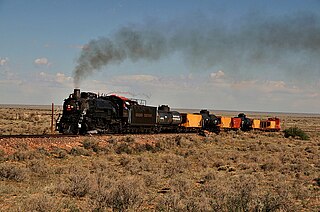
The Grand Canyon Railway is a heritage railroad which carries passengers between Williams, Arizona, and the South Rim of Grand Canyon National Park.

Santa Fe Depot, also known as the Santa Fe Transit Hub, is an Amtrak station located in downtown Oklahoma City, Oklahoma. It is the northern terminus of the Heartland Flyer, a daily train to Fort Worth, Texas.

Norman is an Amtrak station in Norman, Oklahoma. The station is serviced by the daily Heartland Flyer, which travels from Fort Worth, Texas to Oklahoma City, Oklahoma. The station building was added to the National Register of Historic Places in 1991 as the Santa Fe Depot.

Claremont station is a passenger rail and bus station in Claremont, California, United States. It is served by Metrolink's San Bernardino Line which runs from Los Angeles Union Station to San Bernardino–Downtown. The Mission Revival-Spanish Colonial Revival style station is listed on the U.S. National Register of Historic Places as Atchison, Topeka and Santa Fe Railroad Station.

The San Bernardino Santa Fe Depot is a Mission Revival Style passenger rail terminal in San Bernardino, California, United States. It has been the primary station for the city, serving Amtrak today, and the Santa Fe and Union Pacific Railroads in the past. Until the mid-20th century, the Southern Pacific Railroad had a station 3/4 of a mile away. It currently serves one Amtrak and two Metrolink lines. The depot is a historical landmark listed on the National Register of Historic Places as Atchison, Topeka and Santa Fe Railway Passenger and Freight Depot.

The Santa Fe Passenger Depot, also known as Fresno station, is an historic railroad station and transportation hub in downtown Fresno, California. It is served by San Joaquins inter-city passenger trains, Greyhound inter-city buses, and regional transit services including Fresno Area Express and the Fresno County Rural Transit Agency.

Gainesville, officially the Gainesville Santa Fe Depot, is an Amtrak train station in Gainesville, Texas. The station is serviced by Amtrak's Heartland Flyer route, which travels from Fort Worth, Texas to Oklahoma City, Oklahoma.
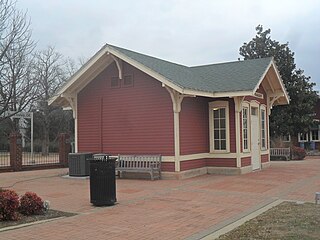
Pauls Valley is an Amtrak station in Pauls Valley, Oklahoma. The station is serviced by the daily Heartland Flyer, which travels from Oklahoma City, Oklahoma to Fort Worth, Texas.
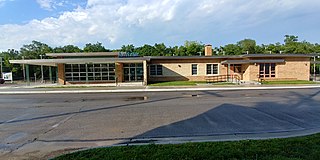
Lawrence station is a train station in Lawrence, Kansas, United States, served by Amtrak's Southwest Chief train. Built in 1956 to replace an older station, it was added to the National Register of Historic Places in 2018 as Santa Fe Depot.

The Atchison, Topeka and Santa Fe Passenger and Freight Complex is a nationally recognized historic district located in Fort Madison, Iowa, United States. It was listed on the National Register of Historic Places in 1992. At the time of its nomination it contained three resources, all of which are contributing buildings. The buildings were constructed over a 24-year time period, and reflect the styles that were popular when they were built. The facility currently houses a local history museum, and after renovations a portion of it was converted back to a passenger train depot for Amtrak, which opened on December 15, 2021.

Pueblo Union Depot is the historic railroad station in Pueblo, Colorado. It was built in the Richardsonian Romanesque style in 1889–1890 and added to the National Register of Historic Places in 1975. It is located within the Union Avenue Historic Commercial District.
Atchison, Topeka and Santa Fe Railway Depot, Santa Fe Depot, Santa Fe Passenger Depot, or variations with Railroad or Station or Passenger and/or Freight may refer to any one of many stations of the Atchison, Topeka and Santa Fe Railway. These include :

Gulf, Colorado and Santa Fe Railroad Passenger Station is a former passenger train station in Fort Worth, Texas. From 1971 to 2002, it was used as Fort Worth's Amtrak station.

Great Overland Station, listed on the National Register of Historic Places as Union Pacific Railroad Passenger Depot, is a museum and former railroad station in Topeka, Kansas, United States. The station was built from 1925 to 1927 and designed by Gilbert Stanley Underwood, whose firm designed over 20 Union Pacific Railroad stations from 1924 to 1931. The station's Free Classical Revival design uses terra cotta extensively and features a center pavilion with two increasingly smaller pavilions on either side. Passenger service to the station began in January 1927; almost 20,000 people attended the station's grand opening, and the new station was considered "one of the largest and finest stations west of the Missouri River". In the later years of its train station life, it also hosted the passenger trains of the Chicago, Rock Island and Pacific Railroad. The Atchison, Topeka and Santa Fe Railway 'Santa Fe' had its trains stop at its own Topeka station.

The Santa Fe Passenger and Freight Depot is a former Santa Fe Railroad station located at 150 Central Valley Highway in Shafter, in the southern San Joaquin Valley within Kern County, California.

The Redlands Santa Fe Depot District is a historic commercial district and station located in downtown Redlands. The district is centered on Redlands' Atchison, Topeka and Santa Fe Railway depot, which was established in 1888.
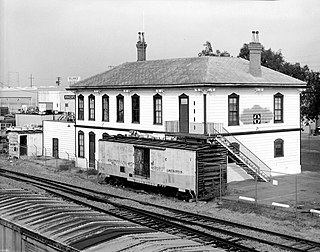
National City station is a former railway station in National City, California. The California Southern Railroad, a subsidiary of the Atchison, Topeka and Santa Fe Railway, chose National City as the West Coast base of operations at the terminus of their planned transcontinental railroad.

The Boone Santa Fe Railroad Depot, at 100 Baker Ave. in Boone, Colorado, was listed on the National Register of Historic Places in 1997.
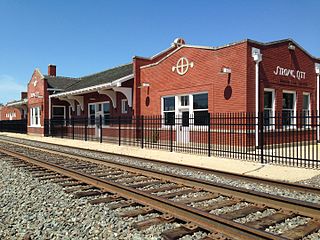
The Strong City Atchison, Topeka & Santa Fe Depot is a historic railway station at 102 W. Topeka Avenue in Strong City, Kansas. The station was built by the Atchison, Topeka and Santa Fe Railway (ATSF) in 1913 to replace the city's previous station. The ATSF first built a line through the city in 1872, bypassing the county seat of Cottonwood Falls. To honor the railroad, the city changed its name from Cottonwood Station to Strong City in 1881 for ATSF vice president William Barstow Strong. Strong City's first railroad station was a simple wood building, and after a 1902 fire the town replaced it with a board-and-batten structure. In the early 1910s, the ATSF began replacing the stations in its most important stops with permanent brick buildings; the new stations were known as county-seat depots, as they typically served a county seat or the most important station in a county. The Strong City depot is typical of the ATSF's corporate architecture at the time and includes elements of the American Craftsman and Mission Revival styles. It served passenger trains until the late 1940s and continued to function as a railway office for many years afterward.

The Osage City station, nominated as the Osage City Santa Fe Depot, is a historic railroad depot building at 508 Market Street in Osage City, Kansas. The depot was on the main line of the Atchison, Topeka and Santa Fe Railway. The construction contract was let in September 1911 with the new depot opening in the Spring of 1912 at a cost of $13,000. The Santa Fe sold the depot to the Osage County Historical Society in 1986, which led to the creation of a local museum.






















